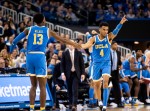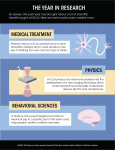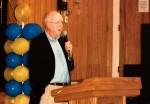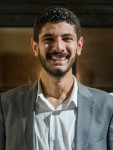Glenn Langer, a former director of cardiovascular research at UCLA who helped mentor more than 600 disadvantaged Los Angeles public school students, died June 19 at 91 years old.
His colleagues from UCLA cardiology and from the college-readiness organization he founded remember him as a heart scientist with a big heart.
“One of my fondest memories is Langer standing in front of a group of high school students and challenging them to consider a career in biology and medicine, and showing them how what we learned in the laboratory helped people live longer and survive,” said Kenneth Shine, former president of the National Academy of Medicine and former dean of the David Geffen School of Medicine.
Langer was recruited in 1960 by the school of medicine to help establish the UCLA Cardiovascular Research Laboratory – better known as the UCLA Heart Lab. He would serve as its director from 1986 to 1997.
Langer and co-founder Allan Brady were able to draw recruits from all over the world to the lab, said James Weiss, the current director of the Heart Lab and UCLA Health chief of cardiology. Weiss said Langer, friendly and able to get researchers excited about their work, had been particularly good at recruitment.
Shine also began his career working under Langer at the Heart Lab. The lab was one of the first to look at the fundamental biology of the heart, he said.
“In my case, … we were able to find ways to preserve the heart so that cardiac surgeons could operate in a heart that was deprived of blood flow for a period of time,” Shine said. “So he introduced a very fundamental science which has continued since at UCLA.”
Langer and Brady brought people from all different fields together to study the heart, Shine added.
“I was able to learn from mathematicians, from people who were good at models of biological processes, from electron microscopists who were among the best in the country,” Shine said. “It was an extraordinary group of individuals.”
Weiss, who moved to LA to pursue his research under Langer, said the lab environment created by Langer was open and friendly.
He said he remembers fondly Langer holding lunches in a large conference room every day with anybody who wanted to join him.
“Usually, any day there’d be maybe 15 or 20 people there, and he always would kind of start the discussion usually going, and he talked about all kinds of things,” Weiss said. “It was a wonderful experience, particularly for the students who came from foreign countries because they didn’t just talk about science. They learned a lot about the American culture and things like that, from talking about anything from politics to history, or whatever was in a newspaper that day.”
Langer kept his office door open to all students and faculty, and anybody could stop in to talk about anything they wanted with him, Shine said. Students would talk to Langer about their research, and Langer would offer his own ideas.
But when the students were ready to publish their research papers and asked to put Langer’s name on them, Langer would refuse, Shine said.
“At a time when many people were putting multiple names on scientific papers … only because the (student) worked in their laboratory, this was a generous approach,” he said. “I found that (Langer) set an example, which I tried to follow throughout my career.”
One of Langer’s greatest legacies at the Heart Lab and at UCLA was the people who learned from him and would go on to emulate him in their own careers, Shine said.
“I always learned to give other people credit for success, and take responsibility for failure myself,” Shine said. “That was one of the themes of my professional career, and I learned that from him.”
Langer was also a distinguished professor in medicine and physiology. He was the first to hold the Castera Endowed Chair in Cardiology, and he served as the school of medicine’s associate dean of research. He retired in 1997.
He also volunteered with students at Lennox Middle School as part of an outreach program for years before he retired, said Meg Sanchez, former vice principal of Lennox Middle School. Sanchez would help him start his own mentorship program in 1996.
As he interacted with the students, he learned many of them had never been outside of the 1.4-square-mile area in which they had grown up, Sanchez said. In Lennox Middle School’s district in 1996, only 15% of high school students were going on to attend college, according to the LA Times. Langer wanted them to have access to the same resources as any middle-class student, she added.
The idea to begin a program to sponsor disadvantaged public school students sparked at a luncheon sometime around 1996, Shine said.
“He said to me, ‘You know, it’s amazing,’” Shine said. “‘There (are) so many really bright young people in these schools. They’re not even thinking about college as an opportunity.’ And you could see the light go on in his head.”
Over the following few years, Langer, with the support and help of his wife, would take $235,000 from his own retirement savings to provide books, supplies and private high school tuition to students from Lennox Middle School, according to the LA Times. He also reached out to friends and colleagues from the medical community to ask them to donate, Sanchez said.
The Partnership Scholars Program, which arose out of the first scholarships he provided, began receiving donations from the public after the LA Times covered it in 1999, Sanchez said. It has now graduated over 620 students, according to its website.
PSP provides each of its students a mentor for six years, starting while the student is in seventh grade, and $10,400 in grants, according to its website. The program also brings its students on educational and cultural trips around LA and across the country, Sanchez said.
Langer, born during the Great Depression, had only been able to attend college himself because he had been supported by a private foundation, Weiss said. Langer started PSP because he wanted other disadvantaged children to understand higher education was attainable for them, he added.
“So that’s what he really devoted the rest of his life to,” Weiss said.
Langer would spend 30 to 40 hours a week making phone calls and writing emails to bring in donations, in a room in his house devoted entirely to the program, Sanchez said.
She added Langer was like a grandfather to many of the students in PSP.
“He was a good listener,” she said. “He wanted to hear about the kids. He wanted to know what they were studying, what they aspired to. He would ask them questions, and he would make them feel comfortable enough to really confide in him.”
Sanchez said she has mentored almost 60 students in the years since starting the program. Several were inspired to pursue medicine or attend UCLA because of Langer, she said.
“Kids … stayed away from friends who would lead them down the wrong path because they said, ‘Nope, Dr. Langer would not approve,’” she said. “I don’t think you could find a scholar who wouldn’t credit at least some of their success to Dr. Langer.”
Langer also leaves behind a legacy in cardiovascular research, Shine said.
“And he did it in this very generous, open way, which made him beloved,” he said.
Langer is survived by his wife, daughter, stepson, four grandchildren and three step-grandchildren.





